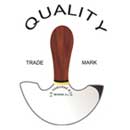
12 Sep What They Don’t Teach You About Leathercraft Mastery
There are books, tutorials, and countless videos about working with leather. They’ll show you how to cut, how to stitch, and how to finish an edge. But true mastery lives in places that can’t always be explained in steps. It’s built in the quiet hours, in the tiny adjustments, in lessons learned by feel rather than by instruction.
The Patience Behind Perfection
Leather doesn’t rush. It resists shortcuts. The craftsman who masters the art understands that time itself is part of the process. Stitching too quickly, cutting without sharpening, or burnishing with impatience leaves flaws that can’t be hidden.
The secret isn’t speed, it’s rhythm. Mastery shows up when each action is deliberate, no matter how small.
The Role of Intuition
Guides will tell you where to measure, where to punch, and how to align. But intuition is what tells you when the material is ready, when the tool has hit just right, or when to adjust pressure by the smallest degree.
That instinct develops only through hours of practice. It’s not taught, it’s earned.
Tools as Teachers
Everyone knows you need knives, awls, groovers, and burnishers. What they don’t say is that tools have personalities. A blade that has been sharpened and resharpened becomes familiar, almost alive in the hand.
An awl that fits the palm perfectly changes the way stitches line up. Over time, tools don’t just perform tasks; they train the hand to move with precision.
Mistakes that Shape the Craft
Perfection isn’t the real teacher; mistakes are. Uneven stitching, ragged cuts, or rough edges reveal exactly where improvement is needed. Many new leatherworkers try to hide errors. Masters study them. Every misstep points the way toward refinement, and eventually, toward mastery.
Some of the unspoken lessons mistakes provide include:
- The sharper the blade, the safer the cut
- Tension in the thread changes everything about a stitch
- Dry leather resists finishing, but well-conditioned hides respond with grace
- Edges reveal more about technique than any other part of the craft
The Unseen Layer of Discipline
What separates fine leatherwork from the rest is consistency. Not just in one piece, but in every piece. Mastery means sharpening tools even when you’re tired, conditioning leather before you cut, and practicing stitches when no one is watching.
These habits don’t make headlines, but they build the foundation of work that lasts.
Conclusion
The truth about leathercraft mastery is that it’s never finished. There’s always another lesson, another adjustment, another subtle improvement waiting to be discovered. It’s less about reaching a destination and more about entering into a lifelong conversation with the material and the tools.
And that’s the part no one can truly teach; you have to find it in your own hands.


